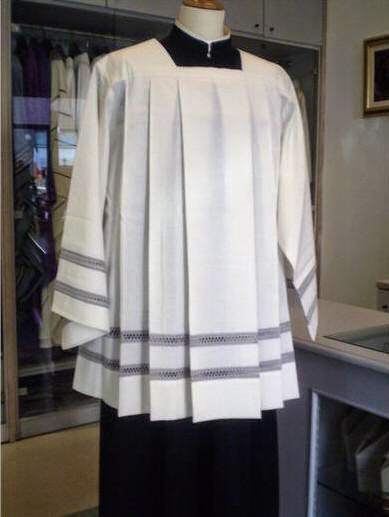Surplice
 A surplice (Late Latin superpelliceum, from super, "over" and pellis, "fur") is a liturgical vestment of the Western Christian Church. The surplice is in the form of a tunic of white linen or cotton fabric, reaching to the knees or to the ankles, with wide or moderately wide sleeves.
A surplice (Late Latin superpelliceum, from super, "over" and pellis, "fur") is a liturgical vestment of the Western Christian Church. The surplice is in the form of a tunic of white linen or cotton fabric, reaching to the knees or to the ankles, with wide or moderately wide sleeves.
It was originally a long garment with open sleeves reaching nearly to the ground, as it remains in the Anglican tradition, but in the Catholic tradition, the surplice often has shorter, closed sleeves and square shoulders. Anglicans typically refer to a Roman-style surplice with the Medieval Latin term cotta [meaning 'cut-off' in Italian], as it is derived from the cut-off alb. English-speaking Catholics, however, typically do not make the distinction between the two styles, and refer to both by the term "surplice".
Origin and variation
It seems most probable that the surplice first appeared in France or England, whence its use gradually spread to Italy. It is possible that there is a connection between the surplice and the Gallican or Celtic alb, an ungirdled liturgical tunic of the old Gallican Rite, which was superseded during the Carolingian era by the Roman Rite. The founding of the Augustinian Canons in the second half of the eleventh century may have had a special influence upon the spread of the surplice. Among the Augustinian Canons the surplice was not only the choir vestment, but also a part of the habit of the order.
The surplice originally reached to the feet, but as early as the 13th century it began to shorten, though as late as the 15th century it still fell to the middle of the shin, and only in the 17th and 18th centuries in Continental Europe did it become considerably shorter. In several localities it underwent more drastic modifications in the course of time, which led to the appearance of various subsidiary forms alongside the original type. For example:
the sleeveless surplice, which featured holes at the sides to put the arms through
the surplice with slit arms or lappets (so-called "wings") instead of sleeves, often worn by organists today, due to the ease of maneuvering the arms
the surplice with not only the sleeves but the body of the garment itself slit up the sides, precisely like the modern dalmatic
a sort of surplice in the form of a bell-shaped mantle, with a hole for the head, which necessitated the arms sticking out under the hem.
The first two of these forms developed very early; and, in spite of their prohibition by synods here and there (for example that of Liège circa 1287), they survive in various places to the present day. The latter two only appeared after the close of the Middle Ages: the first of them in South Germany, the second more especially in Venetia, where numerous pictorial records attest its use. As a rule, however, only the lower clergy wore these subsidiary forms of surplice. They came about partly under the influence of secular fashions, but more particularly for convenience.



EmoticonEmoticon